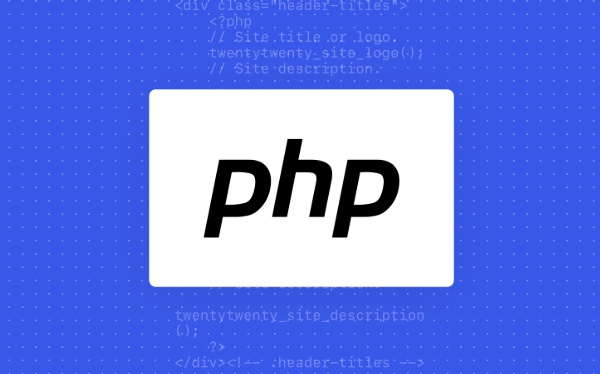 Backend Development
Backend Development
 PHP Tutorial
PHP Tutorial
 A Deep Dive into `array_walk` for Complex Array Transformations
A Deep Dive into `array_walk` for Complex Array Transformations
A Deep Dive into `array_walk` for Complex Array Transformations
Aug 02, 2025 pm 03:28 PMarray_walk is a powerful function in PHP for modifying array elements in place. It is suitable for scenarios where complex transformations are required based on key names, nested structures, or external states. 1. It directly modifies the original array through references; 2. The callback function can access keys and values and supports the context of the third parameter; 3. It can process multi-dimensional arrays in combination with recursion; 4. It is suitable for batch modification of object properties; 5. It does not return a new array, and its performance is better than array_map, but it is not suitable for scenarios where the original array needs to be retained. When used correctly, it performs efficiently and has a clean code in handling context-sensitive or recursive data transformations.

When working with arrays in PHP, array_walk is a powerful yet often underutilized function for applying custom transformations directly to array elements. Unlike functions such as array_map , which returns a new array, array_walk modify the original array in place by applying a user-defined callback to each element. This makes it particularly useful for complex, context-aware transformations where you need to alter values based on their keys, nested structures, or external state.

Let's take a deep dive into array_walk , exploring its capabilities, limitations, and advanced use cases for handling complex array operations.
Understanding the Basics of array_walk
The signature of array_walk is:

array_walk(array &$array, callable $callback, mixed $arg = null): bool
-
$arrayis passed by reference, meaning changes inside the callback affect the original array. -
$callbackreceives at least two arguments: the value (by reference) and the key. - An optional third parameter can be passed to the callback via the
$argargument.
Example:
$fruits = ['apple' => 'red', 'banana' => 'yellow'];
array_walk($fruits, function(&$value, $key) {
$value = strtoupper($value) . " ($key)";
});
// Result: ['apple' => 'RED (apple)', 'banana' => 'YELLOW (banana)'] Note: The return value is true on success, false otherwise — so it doesn't return a transformed array like array_map .

Why Use array_walk Over array_map ?
While both functions apply callbacks to array elements, here's when array_walk shines:
- In-place modification : No need to reassign or create a new array.
- Access to keys : Keys are readily available in the callback without extra effort.
- Working with associated arrays : Ideal when logic depends on key names.
- Performance : Slightly more efficient for large arrays when you don't need a new copy.
However, array_walk only works on one dimension at a time and doesn't handle multi-dimensional arrays natively — that's where things get interesting.
Handling Nested Arrays with Recursive array_walk
For deeply nested structures (eg, arrays of arrays), array_walk can be combined with recursion to apply transformations throughout.
Example: Convert all string values to uppercase in a nested array.
function deepUppercase(&$array) {
array_walk($array, function(&$value, $key) {
if (is_array($value)) {
deepUppercase($value); // Recurse into sub-arrays
} elseif (is_string($value)) {
$value = strtoupper($value);
}
});
}
$data = [
'user' => [
'name' => 'alice',
'prefs' => ['theme' => 'dark', 'lang' => 'en']
],
'status' => 'active'
];
deepUppercase($data);
// All strings are now uppercaseThis pattern is useful for sanitizing input, normalizing data formats, or preparing arrays for output.
Using the Third Parameter ( $arg ) for Context
The optional third parameter in array_walk allows you to pass additional context into the callback — useful when your transformation logic depends on external variables or rules.
Example: Prefix values based on a dynamic category.
$items = ['title' => 'Introduction', 'body' => 'Content here'];
$prefixRules = [
'title' => '[TITLE] ',
'body' => '[BODY] '
];
array_walk($items, function(&$value, $key, $prefixes) {
if (isset($prefixes[$key])) {
$value = $prefixes[$key] . $value;
}
}, $prefixRules);
// Result: ['title' => '[TITLE] Introduction', 'body' => '[BODY] Content here'] This avoids using global variables or closings with use , making the code more testable and reusable.
Working with Object Properties in Arrays
array_walk is also effective when dealing with arrays of objects, especially when you want to modify object properties in bulk.
Example: Update the status property of user objects.
class User {
public $name;
public $status;
public function __construct($name, $status) {
$this->name = $name;
$this->status = $status;
}
}
$users = [
new User('Alice', 'active'),
new User('Bob', 'inactive')
];
array_walk($users, function($user) {
$user->status = 'verified-' . $user->status;
});
// All users now have prefixed status Note: Since objects are passed by reference in PHP, you don't need &$user — but you do need to ensure the property is modifiable (ie, public or via setter).
Common Pitfalls and Gotchas
- Only works on arrays with string/integer keys : Not suitable for objects unless cast.
- Doesn't traverse multidimensional arrays automatically : Requires recursion.
- Callback must accept parameters correctly : The value is often passed by reference; mismatched signatures can cause warnings.
- No return value from callback is used : Unlike
array_map, the return of the callback is ignored.
Also, be cautious with strict typing or references:
// This may cause issues if $value is not a variable
array_walk($arr, function(&$value) {
$value = some_function($value);
});Ensure the array elements are variables (not expressions) to avoid "Only variables can be passed by reference" errors.
When Not to Use array_walk
- You need a new transformed array: Use
array_map. - You're transforming values independently and immutably:
array_mapis cleaner. - Working with non-array traversables: Use
foreachor iterators instead.
Also, for simple operations (eg, incrementing numbers), a plain foreach loop is often more readable and faster.
In summary, array_walk excels in scenarios where you need to modify an array in place , leverage key-value context , or apply side effects or recursive logic . It's not always the most obvious choice, but in the right context — especially for complex, hierarchical data transformations — it offers a clean, efficient solution.
Basically, if you're mutating existing arrays and care about keys or nesting, array_walk is worth having in your toolkit.
The above is the detailed content of A Deep Dive into `array_walk` for Complex Array Transformations. For more information, please follow other related articles on the PHP Chinese website!

Hot AI Tools

Undress AI Tool
Undress images for free

Undresser.AI Undress
AI-powered app for creating realistic nude photos

AI Clothes Remover
Online AI tool for removing clothes from photos.

Clothoff.io
AI clothes remover

Video Face Swap
Swap faces in any video effortlessly with our completely free AI face swap tool!

Hot Article

Hot Tools

Notepad++7.3.1
Easy-to-use and free code editor

SublimeText3 Chinese version
Chinese version, very easy to use

Zend Studio 13.0.1
Powerful PHP integrated development environment

Dreamweaver CS6
Visual web development tools

SublimeText3 Mac version
God-level code editing software (SublimeText3)

Hot Topics
 PHP Variable Scope Explained
Jul 17, 2025 am 04:16 AM
PHP Variable Scope Explained
Jul 17, 2025 am 04:16 AM
Common problems and solutions for PHP variable scope include: 1. The global variable cannot be accessed within the function, and it needs to be passed in using the global keyword or parameter; 2. The static variable is declared with static, and it is only initialized once and the value is maintained between multiple calls; 3. Hyperglobal variables such as $_GET and $_POST can be used directly in any scope, but you need to pay attention to safe filtering; 4. Anonymous functions need to introduce parent scope variables through the use keyword, and when modifying external variables, you need to pass a reference. Mastering these rules can help avoid errors and improve code stability.
 How to handle File Uploads securely in PHP?
Jul 08, 2025 am 02:37 AM
How to handle File Uploads securely in PHP?
Jul 08, 2025 am 02:37 AM
To safely handle PHP file uploads, you need to verify the source and type, control the file name and path, set server restrictions, and process media files twice. 1. Verify the upload source to prevent CSRF through token and detect the real MIME type through finfo_file using whitelist control; 2. Rename the file to a random string and determine the extension to store it in a non-Web directory according to the detection type; 3. PHP configuration limits the upload size and temporary directory Nginx/Apache prohibits access to the upload directory; 4. The GD library resaves the pictures to clear potential malicious data.
 Commenting Out Code in PHP
Jul 18, 2025 am 04:57 AM
Commenting Out Code in PHP
Jul 18, 2025 am 04:57 AM
There are three common methods for PHP comment code: 1. Use // or # to block one line of code, and it is recommended to use //; 2. Use /.../ to wrap code blocks with multiple lines, which cannot be nested but can be crossed; 3. Combination skills comments such as using /if(){}/ to control logic blocks, or to improve efficiency with editor shortcut keys, you should pay attention to closing symbols and avoid nesting when using them.
 How Do Generators Work in PHP?
Jul 11, 2025 am 03:12 AM
How Do Generators Work in PHP?
Jul 11, 2025 am 03:12 AM
AgeneratorinPHPisamemory-efficientwaytoiterateoverlargedatasetsbyyieldingvaluesoneatatimeinsteadofreturningthemallatonce.1.Generatorsusetheyieldkeywordtoproducevaluesondemand,reducingmemoryusage.2.Theyareusefulforhandlingbigloops,readinglargefiles,or
 Tips for Writing PHP Comments
Jul 18, 2025 am 04:51 AM
Tips for Writing PHP Comments
Jul 18, 2025 am 04:51 AM
The key to writing PHP comments is to clarify the purpose and specifications. Comments should explain "why" rather than "what was done", avoiding redundancy or too simplicity. 1. Use a unified format, such as docblock (/*/) for class and method descriptions to improve readability and tool compatibility; 2. Emphasize the reasons behind the logic, such as why JS jumps need to be output manually; 3. Add an overview description before complex code, describe the process in steps, and help understand the overall idea; 4. Use TODO and FIXME rationally to mark to-do items and problems to facilitate subsequent tracking and collaboration. Good annotations can reduce communication costs and improve code maintenance efficiency.
 Quick PHP Installation Tutorial
Jul 18, 2025 am 04:52 AM
Quick PHP Installation Tutorial
Jul 18, 2025 am 04:52 AM
ToinstallPHPquickly,useXAMPPonWindowsorHomebrewonmacOS.1.OnWindows,downloadandinstallXAMPP,selectcomponents,startApache,andplacefilesinhtdocs.2.Alternatively,manuallyinstallPHPfromphp.netandsetupaserverlikeApache.3.OnmacOS,installHomebrew,thenrun'bre
 How to access a character in a string by index in PHP
Jul 12, 2025 am 03:15 AM
How to access a character in a string by index in PHP
Jul 12, 2025 am 03:15 AM
In PHP, you can use square brackets or curly braces to obtain string specific index characters, but square brackets are recommended; the index starts from 0, and the access outside the range returns a null value and cannot be assigned a value; mb_substr is required to handle multi-byte characters. For example: $str="hello";echo$str[0]; output h; and Chinese characters such as mb_substr($str,1,1) need to obtain the correct result; in actual applications, the length of the string should be checked before looping, dynamic strings need to be verified for validity, and multilingual projects recommend using multi-byte security functions uniformly.
 Learning PHP: A Beginner's Guide
Jul 18, 2025 am 04:54 AM
Learning PHP: A Beginner's Guide
Jul 18, 2025 am 04:54 AM
TolearnPHPeffectively,startbysettingupalocalserverenvironmentusingtoolslikeXAMPPandacodeeditorlikeVSCode.1)InstallXAMPPforApache,MySQL,andPHP.2)Useacodeeditorforsyntaxsupport.3)TestyoursetupwithasimplePHPfile.Next,learnPHPbasicsincludingvariables,ech





